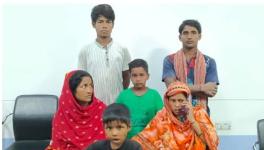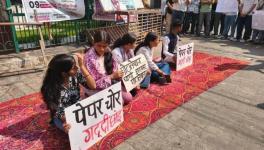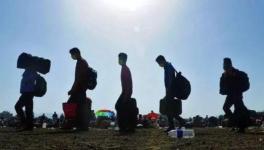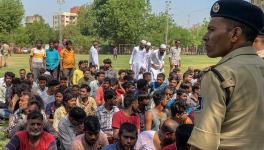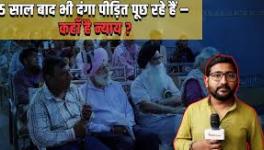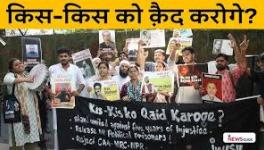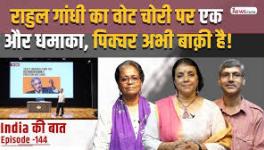The Missing Millions of Migrants from Modi’s Speech—and Our News
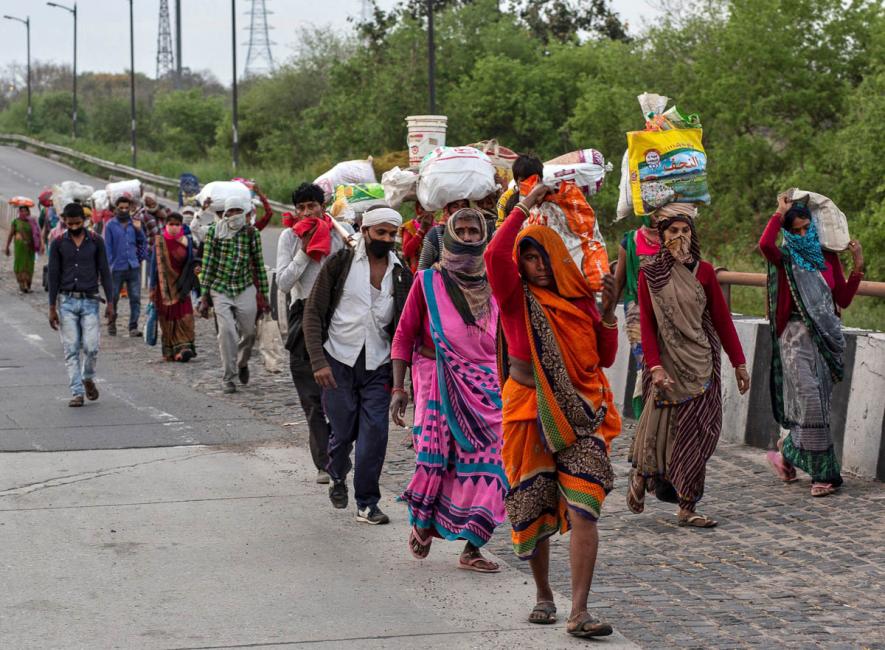
Image Courtesy: Reuters
By any measure, this has been an extraordinarily tumultuous and brutal year for India. It’s the sort that perhaps comes once in a century—economic slowdown, raging pandemic, stringent lockdown to control it, millions stranded and suffering inexplicable police cruelties, gagging of free press and speech, delegitimising dissent and dissenters, before that the introduction of the Citizenship Amendment Act and National Register of Citizens, and the scrapping of Article 370 that changed the status of Jammu and Kashmir. The extraordinariness was not apparent in Prime Minister Narendra Modi’s address to the nation to mark the Independence Day.
The notes of tumult and severity did not find echoes in his 90-minute address. In his trademark style of skipping the inconvenient, he avoided most and perfunctorily touched upon a few. More disquieting was that a section of Indians went missing from the wide range of subjects he spoke about. The crushing human tragedy of our time—the plight of 100-140 million Indians, migrant workers, hit the hardest by the pandemic and lockdown—hardly found a mention.
Modi’s abrupt announcement of lockdown on 24 March sent their delicately balanced lives over the edge. They lost or were thrown out of jobs overnight, left with no food and money for rent, they could no longer afford to live in cities and, in the absence of public transport, made their way back home to villages on foot or cycles covering hundreds of kilometres across state borders. This, they did without proper food or rest. Nearly 200 died in road accidents. Migration scholars have termed it the largest movement of Indians since independence and Partition.
They had not figured in Modi’s speech on 24 March when he locked down the country with four-hour notice; they were not part of his 15 August speech despite evidence of their immense pain since. By extension, because news priorities get set by what those in power say and do, stories of migrants have largely gone missing from the mainstream media too. It discovered them in late March; most media forgot them a few weeks later.
Here’s a list of subjects Modi chose to dwell upon from the Red Fort: National Digital Health Mission, three Covid-19 vaccines in different stages of trial, new cyber security policy, sanitary napkins at one rupee and possibly raising the age of marriage for girls to 21 years, six lakh villages across India to be connected by optical fibre in the next 1,000 days, Rs.100 lakh crore national infrastructure project, expansion of the National Cadet Corps, the New Education Policy unveiled last week, commendation for Corona warriors, and his seasonal favourite “Atmanirbhar Bharat”.
There was the expected self-congratulatory reference to Ram Temple. He refashioned India’s most divisive issue of the last three decades as one that got resolved “peacefully”. Also, he referred to the scrapping of Article 370 last year and gushed that it had ushered in “development” for Jammu and Kashmir which would see an election soon. He spoke of making Ladakh—a region with barely 0.1% of India’s total emissions—carbon neutral. The long ramble did not include the plight and pain of millions of migrants, lower caste and daily wage workers; there were no words of solace or reassurance for them.
These Indians may have fallen off Modi government’s agenda and news cycles, but the issue is smouldering. Studies have shown the devastating impact of continued lockdown on their work, wage and life; reports highlight their suffering, and recommendations have been put out by independent think tanks and advocacy groups. Only a few of these have found some space in the media, almost none have been publicly acknowledged by the Modi government.
The lockdown was hardly a leveller; the loss of jobs unfavourably affected workers from lower castes than higher castes, pointed out a recent paper by Ashoka University. There was a sharp fall in employment across all groups between December 2019 and April 2020, but job loss was three times more for Scheduled Caste workers than for higher caste and two times more for OBCs and Scheduled Tribes. Job loss among the higher caste was 7% whereas it was 20% for SCs, 15% for STs and 14% for OBCs, the paper showed. Based on a nationally representative sample of 21,799 skilled and unskilled workers collected by Centre for Monitoring Indian Economy (CMIE), the findings underscored the need for targeted welfare measures.
“The difference in job losses among lower and higher castes is explained by the types of jobs they do and their education,” said the University’s economics professor Ashwini Deshpande. She co-authored the study titled “Is Covid-19 ‘The Great Leveler’? The Critical Role of Social Identity in Lockdown-induced Job Losses” with economist Rajesh Ramachandran of Goethe University in Germany. “Since Scheduled Castes are more concentrated in daily wage jobs and since daily wagers lost jobs in greater proportion than those with formal jobs, the difference in job losses was capturing that (caste difference), and this was more pronounced in workers with less than 12 years of education,” Prof Deshpande told NewsClick.
There was “a massive increase in unemployment and an equally dramatic fall in earnings with two-thirds of respondents losing work and the few informal workers still employed seeing their earnings drop by half…the impact of job losses and food insecurity has been higher for certain groups like Muslims, Dalits, women, those with lower levels of education, and migrants,” found a survey conducted between April and May by Azim Premji University’s Centre for Sustainable Employment (CSE). An overwhelming majority of farmers could not sell their produce or had to sell at lower prices, it noted.
The impact of the lockdown was so severe on those at the bottom of the pyramid including migrant workers that “almost 8 in 10 people were eating less food than earlier, an equal number did not have money for rent, more than 6 in 10 in urban areas did not have money for a week’s worth of essentials, and more than a third had taken loans to cover expenses during the lockdown,” the survey found.
The International Labour Organisation had flagged this off early. The pandemic and lockdown crisis would mean nearly 400 million workers in India—given that almost 90% work in the informal economy—are at risk of falling deeper into poverty, it had stated. For India, a joint ILO-Asian Development Bank report estimated on Tuesday that 41 lakh youth have already lost their jobs due to the pandemic.
The government’s schemes – whether targeted delivery or stimulus package – have meant little. In May, the government said Rs 18,253 crore had been disbursed to 91.3 million farmers under the PM-KISAN scheme as part of Rs.1.70 trillion Pradhan Mantri Garib Kalyan Package (PMGKP) relief measure. But this left out four in every 10 farmers, millions of agricultural labourers and tenant farmers, according to CSE’s findings.
Free food grains-pulses for migrants and poor were announced three weeks after the lockdown began. Barely a third of the migrants benefited; only 2,46,000 of 8,00,000 tonnes of the allocated foodgrains were distributed, according to a report in Hindustan Times. Migrant workers count among agricultural labourers and rural poor who, along with pregnant women and children, have the worst levels of documented malnutrition in India. In the 2019 Global Hunger Index, India ranked a low 102 behind her neighbours Pakistan, Bangladesh and Sri Lanka.
Modi’s Independence Day address chose to not articulate some of the pressing socio-economic issues of the nation at this time. If future historians were to interpret the speech, it’s as if the severe human suffering—millions walking miles in a shuttered down nation, losing jobs, going hungry—caused in great part by his government’s unplanned and abrupt lockdown did not happen.
Like extras in a mega movie with a superhero, they exist to fill in the frame but cannot be foregrounded. When they do appear in the national political or media narrative, they are projected as beneficiaries of India’s gigantic economic machine or government’s generous welfare schemes, but rarely acknowledged for their worth as economic producers, service providers and city builders. On 15 August when Modi announced an optical fibre network for all villages, they must have wondered why this great modern nation cannot build a network for their basic needs.
The author is a senior Mumbai-based journalist who writes on politics, cities, media and gender. The views are personal.
Get the latest reports & analysis with people's perspective on Protests, movements & deep analytical videos, discussions of the current affairs in your Telegram app. Subscribe to NewsClick's Telegram channel & get Real-Time updates on stories, as they get published on our website.









